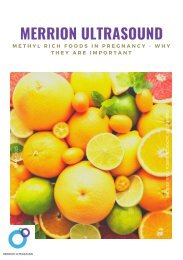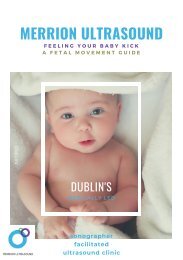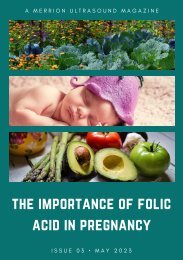The Importance of Vitamin D in Pregnancy
The Importance of Vitamin D in Pregnancy - why you need to take it, the potential effects on baby if you have a deficiency and how to get it.
The Importance of Vitamin D in Pregnancy - why you need to take it, the potential effects on baby if you have a deficiency and how to get it.
Create successful ePaper yourself
Turn your PDF publications into a flip-book with our unique Google optimized e-Paper software.
JULY 2023<br />
MERRION ULTRASOUND<br />
T H E I M P O R T A N C E O F V I T A M I N D I N<br />
P R E G N A N C Y
<strong>The</strong> <strong>Importance</strong> <strong>of</strong> <strong>Vitam<strong>in</strong></strong><br />
D <strong>in</strong> <strong>Pregnancy</strong><br />
WELCOME<br />
Discover why <strong>Vitam<strong>in</strong></strong> D is<br />
important <strong>in</strong> pregnancy and where<br />
to f<strong>in</strong>d it.<br />
<br />
<br />
<br />
<br />
DISCLAIMER<br />
Please do not consider any <strong>of</strong> the<br />
<strong>in</strong>formation provided here as a<br />
substitute for medical advice. At all<br />
times seek medical advice directly<br />
with your own doctor and medical<br />
team.<br />
<br />
PHONE<br />
637 4060<br />
E-MAIL<br />
<strong>in</strong>fo@merrionultrasound.ie<br />
WEBSITE<br />
merrionultrasound.ie
INTRODUCTION<br />
Nutrition dur<strong>in</strong>g, and ideally before pregnancy, is <strong>of</strong> the utmost importance.<br />
<strong>Vitam<strong>in</strong></strong> D is most easily obta<strong>in</strong>ed from sunsh<strong>in</strong>e, which means that pregnant<br />
women <strong>in</strong> Ireland are at a disadvantage <strong>in</strong> comparison to sunnier countries.<br />
This magaz<strong>in</strong>e expla<strong>in</strong>s the role it plays, what can happen to your unborn baby if<br />
you have a <strong>Vitam<strong>in</strong></strong> D deficiency, and also what may happen to you dur<strong>in</strong>g your<br />
pregnancy.<br />
Discover all the essential <strong>in</strong>formation about <strong>Vitam<strong>in</strong></strong> D, as well as how much you<br />
ideally need and where to get it.
AN IGNORED EPIDEMIC<br />
A Global Health Problem<br />
Did you know that <strong>Vitam<strong>in</strong></strong> D deficiency (hypovitam<strong>in</strong>osis D) is considered to be a<br />
global health problem, and has been labeled “an ignored epidemic”? (2)<br />
Pregnant Women In Ireland<br />
Not only this but accord<strong>in</strong>g to a research study, which was published <strong>in</strong> the<br />
European Journal <strong>of</strong> Cl<strong>in</strong>ical Nutrition, pregnant Irish women’s <strong>in</strong>take <strong>of</strong> the<br />
sunsh<strong>in</strong>e vitam<strong>in</strong> is far less than the recommended <strong>in</strong>take required for normal<br />
development <strong>of</strong> their children’s bones. (3)
THE ROLE OF VITAMIN D<br />
▪ Healthy bone development<br />
▪ Good muscle function<br />
▪ Healthy bra<strong>in</strong> development<br />
▪ Proper cardiovascular function<br />
▪ A healthy respiratory system<br />
▪ Strong immune system
VITAMIN D IN PREGNANCY<br />
<strong>Vitam<strong>in</strong></strong> D plays an important role <strong>in</strong> bone health, healthy cell division, and<br />
immune function.<br />
<strong>Vitam<strong>in</strong></strong> D is vital for the absorption, plus the metabolism <strong>of</strong> phosphorus and<br />
calcium.<br />
Mums-to-be with a deficiency <strong>of</strong> <strong>Vitam<strong>in</strong></strong> D may have a high- er risk <strong>of</strong><br />
preeclampsia and be more likely to develop gestational diabetes
VITAMIN D ATTENTION<br />
<strong>The</strong> Relationship<br />
As a fetus is develop<strong>in</strong>g, he/she is entirely dependent on the mother’s supply <strong>of</strong><br />
calcium. <strong>Vitam<strong>in</strong></strong> D is required for normal calcium homeostasis and bone<br />
m<strong>in</strong>eralization. (1)<br />
<strong>The</strong> Attention It Deserves<br />
For a long time, <strong>Vitam<strong>in</strong></strong> D was l<strong>in</strong>ked primarily to childhood rickets and<br />
therefore it did not receive the attention it deserved <strong>in</strong> other areas. In more<br />
recent years this has changed.
THE FULL STORY<br />
Dur<strong>in</strong>g pregnancy <strong>Vitam<strong>in</strong></strong> D deficiency can lead to reduced bone growth<br />
◦<br />
<strong>in</strong> your unborn baby.<br />
It can also lead to poor bone development dur<strong>in</strong>g early childhood.<br />
◦<br />
In severe cases it can cause childhood rickets.<br />
◦<br />
Your baby may be smaller than average.<br />
◦<br />
He/she may have a lower birth weight.<br />
◦<br />
◦ It has been l<strong>in</strong>ked to an <strong>in</strong>creased <strong>in</strong>cidence <strong>of</strong> diabetes.
THE FULL STORY<br />
• Your child may be at higher risk to develop allergies.<br />
• <strong>The</strong>re is a risk <strong>of</strong> neonatal hypocalcemia.<br />
• Your child may have a higher risk <strong>of</strong> schizophrenia.<br />
• <strong>The</strong>re can be a higher disposition to autoimmune disease <strong>in</strong> later life.<br />
• <strong>The</strong>re may be bra<strong>in</strong> development issues.<br />
• You child could be more prone to acute lower respiratory <strong>in</strong>fections.<br />
• <strong>The</strong>re can be a higher risk <strong>of</strong> HIV transmission.
POSSIBLE HEALTH ISSUES<br />
• Cancer<br />
• Diabetes<br />
• Hypertension (high blood pressure)<br />
• Multiple sclerosis (MS)<br />
• Cognitive impairment <strong>in</strong> the elderly<br />
• Depression<br />
• SAD (seasonal affective disorder)<br />
• Obesity<br />
• Osteoporosis<br />
• Various bone disorders<br />
• Parathyroid problems<br />
• Heart disease
HOW MUCH VITAMIN D?<br />
<strong>The</strong> subject <strong>of</strong> how much <strong>Vitam<strong>in</strong></strong> D is enough has been debatable for quite a<br />
while. <strong>The</strong> circulat<strong>in</strong>g 25OHD concentration sufficient to meet the physiological<br />
needs <strong>of</strong> humans is an ongo<strong>in</strong>g subject <strong>of</strong> debate. (14)<br />
Additionally, both our changed lifestyle and the risk <strong>of</strong> sk<strong>in</strong> cancer have made us<br />
less likely to spend time with our sk<strong>in</strong> exposed to the sun.
VITAMIN D TOXICITY<br />
Many people follow the recommendations to use sunscreen when they do spend<br />
time <strong>in</strong> the sun, but this reduces the absorption <strong>of</strong> <strong>Vitam<strong>in</strong></strong> D.<br />
Also over the years, there have been scares regard<strong>in</strong>g <strong>Vitam<strong>in</strong></strong> D toxicity.<br />
However accord<strong>in</strong>g to the <strong>Vitam<strong>in</strong></strong> D Council (4) you would need to take 40,000<br />
IU per day for a good few months to risk <strong>Vitam<strong>in</strong></strong> D toxicity or take a massive onetime<br />
dose
WHO IS AT HIGHER RISK?<br />
• Pregnant women<br />
• Those who have limited sun exposure<br />
• People who are obese (11)<br />
• People with darker sk<strong>in</strong><br />
• People who cover up their bodies when go<strong>in</strong>g outside<br />
• Older people who cannot manage to get outdoors enough<br />
• Those who avoid the sun<br />
• Liv<strong>in</strong>g where there is urban pollution<br />
• Vegetarians<br />
• People who have conditions which affect their ability to metabolise <strong>Vitam<strong>in</strong></strong> D<br />
• Babies be<strong>in</strong>g breast-fed by mothers with low levels/deficiencies <strong>of</strong> <strong>Vitam<strong>in</strong></strong> D<br />
• Those liv<strong>in</strong>g <strong>in</strong> Northern Latitudes, above 42º north –where endogenous<br />
productions <strong>of</strong> <strong>Vitam<strong>in</strong></strong> D ceases, from November until March
SPECIFIC IRISH MEDICAL STUDY<br />
In 2011 a study, specific to Ire- land, was carried out under Pr<strong>of</strong>essor Fionnuala Mc<br />
Auliffe, at the UCD School <strong>of</strong> Medic<strong>in</strong>e and Medical Science.<br />
<strong>The</strong> f<strong>in</strong>d<strong>in</strong>gs revealed that pregnant Irish women have an average dietary <strong>in</strong>take<br />
<strong>of</strong> <strong>Vitam<strong>in</strong></strong> D that is 80% below the recommended levels. (3)
VITAMIN D INTAKE<br />
<br />
<strong>The</strong> most effective source <strong>of</strong> vitam<strong>in</strong> D is sunlight: the body produces it <strong>in</strong><br />
response to UVB rays on the sk<strong>in</strong>. However, the latitude <strong>of</strong> Ireland means the<br />
rays are only strong enough dur<strong>in</strong>g the summer months.<br />
<br />
In Ireland, the Recommended Dietary Allowance (RDA) for vitam<strong>in</strong> D dur<strong>in</strong>g<br />
pregnancy and while breastfeed<strong>in</strong>g is 10mcg per day.<br />
<br />
Current recommended levels for the average adult: 10µg/d<br />
<br />
<strong>The</strong> NHS <strong>in</strong> the UK recommends 10 µg/d- 10 micrograms per day
THE SUNSHINE VITAMIN<br />
Often referred to as the sunsh<strong>in</strong>e vitam<strong>in</strong>, <strong>Vitam<strong>in</strong></strong> D is the one vitam<strong>in</strong> that<br />
your body can make when ex- posed to sunsh<strong>in</strong>e.<br />
<br />
You can also get <strong>Vitam<strong>in</strong></strong> D from a limited amount <strong>of</strong> food sources.<br />
<br />
Once your body has <strong>Vitam<strong>in</strong></strong> D, it turns it <strong>in</strong>to a hormone, which is sometimes<br />
referred to as “calcitriol” or “activated <strong>Vitam<strong>in</strong></strong> D.”
MORE THAN 200 GENES<br />
This hormone is responsible for regulat<strong>in</strong>g the functions <strong>of</strong> more than 200 genes.<br />
(2)<br />
It is absolutely essential for growth and development. It works with calcium to<br />
help the body build strong bones and to cont<strong>in</strong>ue to ma<strong>in</strong>ta<strong>in</strong> them.
VITAMIN D SOURCES<br />
Food Sources<br />
<strong>The</strong>re are food sources that conta<strong>in</strong> <strong>Vitam<strong>in</strong></strong> D, such as oily fish, like sard<strong>in</strong>es,<br />
salmon, and mackerel. It is also <strong>in</strong> eggs and meat. Some cereals also have added<br />
<strong>Vitam<strong>in</strong></strong> D.<br />
Sunsh<strong>in</strong>e<br />
<strong>The</strong> best way to get <strong>Vitam<strong>in</strong></strong> D without food or supplements is sunsh<strong>in</strong>e, but<br />
obviously, <strong>in</strong> Ireland, this is not guaranteed.
MERRION<br />
ULTRASOUND<br />
https://merrionultrasound.ie/

















